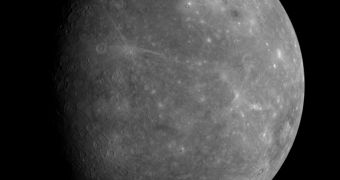At last, we can see the images we've all been waiting for more than three decades, since the first mission to the small planet in the solar system. The first fly-by of the spacecraft MESSENGER around Mercury was a complete success revealing images of a surface battered by multiple collisions, relatively similar to that of our moon. During the gravitational assisted maneuver which took place Tuesday, MESSENGER approached the planet at the short distance of 200 kilometers, passing through its vicinity with an estimated speed of about 25,000 kilometers per hour.
The spacecraft took more than 1,200 images of the planet's surface depicting previously unavailable sights. This is only the second spacecraft ever to be sent towards Mercury. The first mission was conducted by the Mariner 10 spacecraft between 1973 and 1975, when it executed three fly-bys around the planet, made detailed measurements of the magnetosphere and mapped about 45 percent of the planet's surface.
One of the first images taken by MESSENGER was made from a distance of about 27,000 kilometers from the surface of the planet and was released soon after, revealing the presence of the youngest crater in the solar system, Caloris, with a diameter of about 1,300 kilometers. The image of the crater was previously available in the pictures taken by the Mariner 10 spacecraft; however, it only showed the eastern part of the structure.
The bright characteristics spotted during the Tuesday fly-by suggest the presence of a different type of material inside the Caloris crater, which could have been ejected from underneath the surface of the planet during the impact phase.
Another structure observed by the Mariner 10 spacecraft during its mission, the double-ringed crater dubbed Vivaldi, was studied in close view by the MESSENGER spacecraft on 15 January. The 200 kilometer wide crater was photographed from a distance of about 18,000 kilometers, showing how the inner depression of the crater is surrounded by a second ring of material.
Similarly to the Mariner 10 mission, the MESSENGER spacecraft will execute a series of three fly-bys around Mercury before entering into a stable orbit around the planet in 2011. The mission is due to terminate by the end of the next decade, in which time it will try to answer a series of questions related to the planet's density, mass distribution, atmosphere, magnetic field and, last but not least, if it presents any evidence of water on its surface.

 14 DAY TRIAL //
14 DAY TRIAL // 
